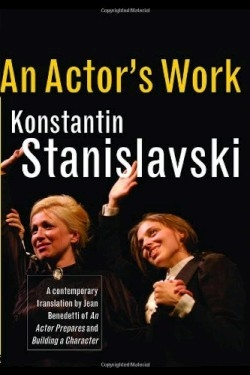An Actor's Work
Widely considered to be one of the greatest acting teachers in history, Konstantin Stanislavski inspired a “method” that is still taught today, nearly ninety years after its introduction. In this important translation, editor Jean Benedetti is sure to bring the master to a new class of students, and keep the method going strong for decades to come.
A Russian actor and theater director, Stanislavski was one of the first to regard acting as a craft that required rigor and integrity to perfect. His “system” may contain some commonsense elements, such as plumbing the emotional depths of a character, but that’s likely because his style has been so adopted by serious actors.
Benedetti has done a great service in creating a very readable blend of two of Stanislavski’s books, previously known as An Actor Prepares and Building a Character. Both have the same, mildly precious device: rather than simply espousing his theories, Stanislavski presents the books as “lecture notes” and diary entries related to a series of talks given by “well-known actor, director and teacher Arkady Tortsov.”
Stanislavski pretends to be the wide-eyed student, but in fact, there’s no real Tortsov, it’s merely the teacher hiding behind yet another character of his own design. But the principles he espouses are so straightforward that they can be applied to many types of art, and even many other kinds of professions.
“The best thing is when creation occurs spontaneously, intuitively, through inspiration,” he writes. “But what if that doesn’t happen? Then there is nothing for it but to stimulate subconscious creation through the conscious means, by our technique.”
Although the work will be most useful for actors—and should, actually, be required reading before cameras roll or curtains part—it’s also compelling material for those who prefer to be part of an audience, rather than in front of one. Much like reading about a novelist’s methods and habits imparts fresh nuance on finished work, understanding the machinations of the acting craft are likely to make a viewer appreciate the art to a deeper degree. This has been the concept behind the TV show “Inside the Actors Studio,” but here, the reader has the benefit of terrific insight without fighting mixed feelings about host James Lipton and his aggressive interviewing style.
Rather than focus on what might work with specific actors, Stanislavski constantly goes back to the fundamentals of what makes for a great actor: imagination, communication, tempo, and discipline.
Reviewed by
Elizabeth Millard
Disclosure: This article is not an endorsement, but a review. The publisher of this book provided free copies of the book to have their book reviewed by a professional reviewer. No fee was paid by the publisher for this review. Foreword Reviews only recommends books that we love. Foreword Magazine, Inc. is disclosing this in accordance with the Federal Trade Commission’s 16 CFR, Part 255.

